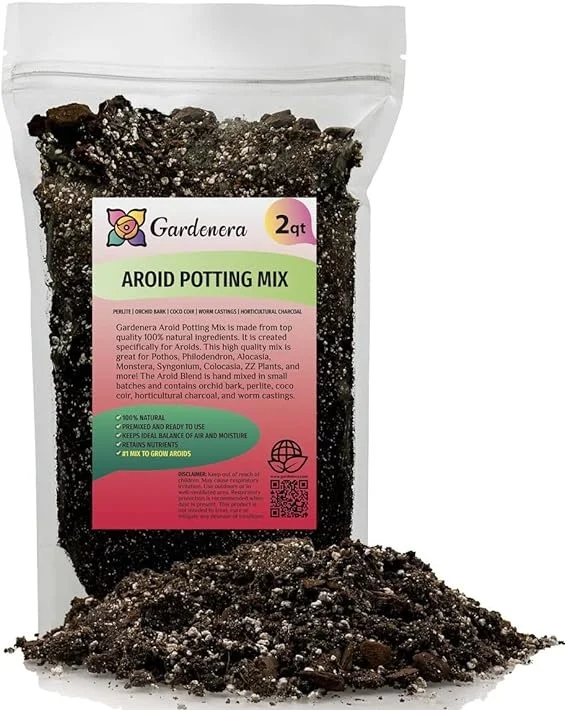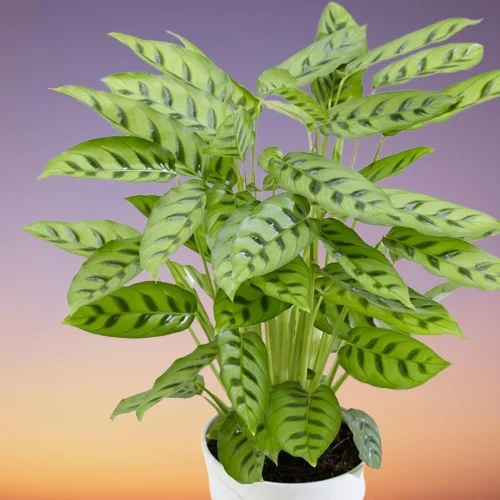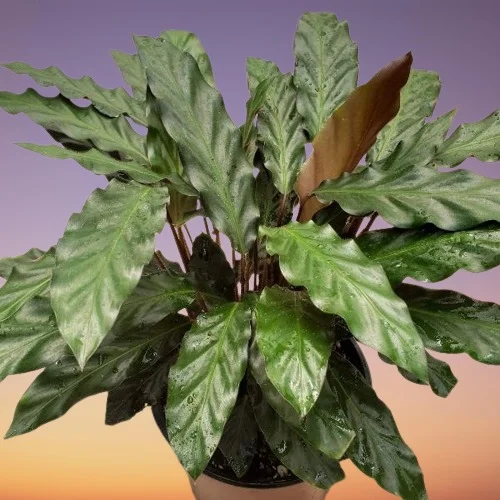Calathea fasciata (Goeppertia fasciata) Indoor Care, Propagation, Problems & Remedies
Some links in this post may be affiliate links
Calathea fasciata also called Goeppertia fasciata grows best in medium indirect light, warm and humid conditions and moderately moist, rich, well-drained soil coupled with monthly feeding in the growing season.
Goeppertia fasciata is among the popular Calathea varieties on account ot its spectacular, glossy, orb-shaped, deep-green leaves with lime-green rib variegation and purple undersides which radiate from the center of the plant.
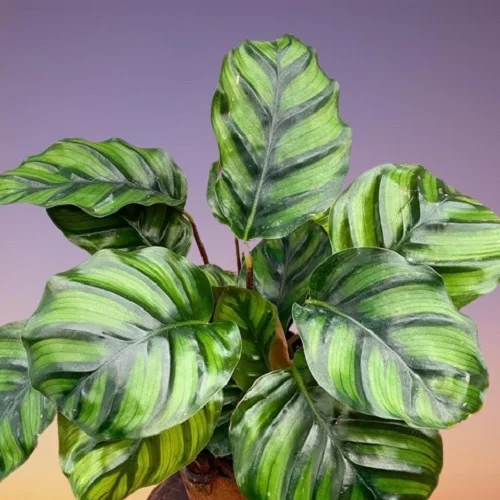
Botanical name: Calathea fasciata
Synonym: Goeppertia fasciata
Family: Marantaceae
Common name: Calathea fasciata
Origin
Calathea fasciata is native to the tropical forests in Northern Brazil where it grows on the forest floors and is one of the favorite tropical foliage plants.
Size
Calathea fasciata grows in clumps to a height of about 1-2 feet making it one of the best low-light plants for the limited spaces.
Flower
Goeppertia fasciata is not grown for the flower but for the pretty foliage and is unlikely to flower under room conditions.
Is Calathea fasciata toxic?
No. Calathea fasciata like other Calathea Plants is non-toxic to both humans and pets as outlined by ASPCA. It is safe to grow indoors.
Related Plants
Calathea fasciata is closely related to the Marantas, Ctenanthe and Stromanthe which are collectively called Prayer Plants in reference to their curious characteristic of closing their leaves at night.
Where to buy
If you would like to add Calathea Plants to your collection, you may acquire these plants from Etsy (Link to Etsy).
How to Care for Calathea fasciata Indoors
To care for Calathea fasciata indoors, give it medium indirect light, warmth of 17-260C, humidity of 60-80% and moderately moist, fertile, well-drained soil coupled with monthly feeding during the growing season.
Goeppertia fasciata care requires pruning to keep it neat and also discourage pest and disease infestations. Repotting is needed only when the plant becomes pot-bound. Keep reading for more on the best growing conditions and how to provide them.
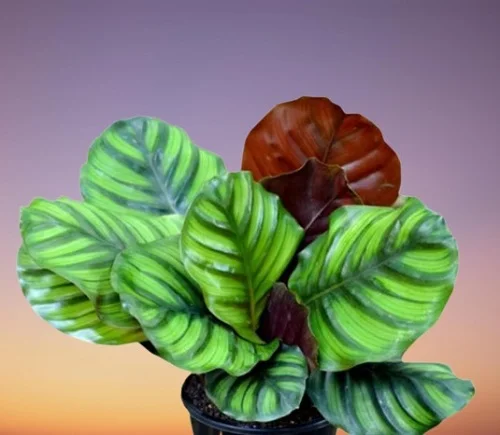
Light Requirements
Calathea fasciata grows best in medium indirect light away from direct sunlight as it can cause loss of leaf colour and scorching of the leaves.
Where the natural lighting is not adequate, you may grow the plant under full spectrum grow lights to prevent yellowing and leggy growth.
For even growth and to prevent lopsided growth, rotate the pot regularly to ensure that the plant receives light on all sides.
Watering
Water Calathea fasciata liberally (until the water comes out through the drainage holes) in spring and summer while allowing the top 2-3 inches of soil to dry out between waterings. Keep the soil moderately moist but not soggy to prevent rotting and yellowing.
Cut down on watering in fall and winter to maintain the soil slightly moist as growth is minimal at this time. Never allow the soil to dry out completely to prevent wilting and drooping.
Use room temperature water to avoid cold shock which can result in reduced growth. The water should also be free of chlorine and flourides as like all Calatheas, it is sensitive to chemicals dissolved in water which can lead to brown leaf tips and edges.
Ensure that the pot has a drainage hole and the soil is well-draining to avoid waterlogging as it can result in root-rot.
Avoid wetting the foliage during watering or water from the bottom instead to reduce fungal infestations like leaf spot diseases.
Temperature & Humidity
Calathea fasciata prefers a warmth of 17-260C. At temperatures below this range, the plant stops growing while temperatures above this range may cause the plant to die.
Keep it away from drafts as they cause sudden changes in temperature which the plant cannot tolerate and may cause it to die.
Calathea fasciata flourishes in a humidity of 60% to 80%. Low humidity causes the plant to develop brown leaf tips and edges. Use a hygrometer to monitor the humidity for the optimum growth of the plant.
To increase humidity, set the pot on a wet pebble tray, use a cool mist humidifier or grow the plant in a well-lit bathroom or other moist areas in the home. Ensure there is good air circulation to reduce fungal diseases.
You may also grow the plant in a closed terrarium as a high humidity can be maintained inside a terrarium. On account of its compact size and affinity for high humidity, Calathea fasciata is among the best plants for a closed terrarium.
Fertilizer
Feed Goeppertia fasciata every 4 weeks in spring and summer with a balanced, liquid fertilizer to promote a lush growth. Stop feeding in fall and winter as growth is reduced and feeding at this time can lead to fertilizer burn.
Regularly, flush out accumulated chemicals (salts) from the soil by running a stream of water through the soil. Allow the stream of water to run for some time and repeat the process several times.
Potting Soil
The best potting soil for Calathea fasciata should be rich in organic matter and free-draining to prevent it from getting soggy while providing the required nutrients. Most potting mixes designed for aroids are perfect for this plant.
Repotting
Repot Calathea fasciata every 2-3 years at the beginning of the growing season when it becomes root-bound. Take care not to injure its delicate roots.
Use a pot one size larger than the current one. Ensure that the pot has a drainage hole and the soil is free-draining to prevent the ssogginess as it can lead to root-rot and eventual death of the plant. Check out these ceramic planters on Amazon.
Before repotting, water the plant thoroughly at least one day before to hasten establishment as a well hydrated plant suffers less repotting shock.
If the plant is large and has outgrown its current pot, divide it into several sections and use the splits to propagate new plants. Repotting may cause the leaves to droop but the plant will eventually recover in about 3-4 weeks once it takes root.
Pruning & Maintenance
Pruning Calathea fasciata is easy. Remove dead and yellow foliage to maintain the plant neat and reduce pest and disease infestations.
Cut the leaves with a clean sharp knife or clean pair of scissors at the base, where the leaf meets the stalk while avoiding unnecessary injury to minimize diseases infestation.
Keep the leaves clean by damp-wiping with a soft cloth to keep them clean and neat as well as minimize pest and disease infestations.
Calathea fasciata Propagation
Calathea fasciata (Goeppertia fasciata) is best propagated by plant division at the beginning of the growing season (in spring) during repotting. Dividing the plant at this time hastens establishment as it is in the active growth phase.
Read more on how to propagate Calathea Plants in 2 easy ways.
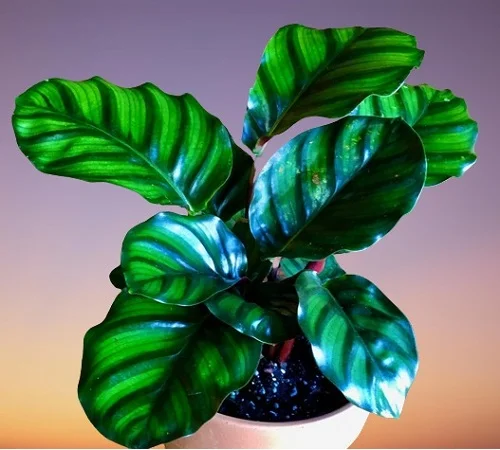
Calathea fasciata Problems & Solutions
Calathea fasciata (Goeppertia fasciata) problems are plant dying, drooping leaves, yellow leaves, brown leaf tips, loss of leaf color, pests and diseases among others. Keep reading for more on these problems and their remedies.
Plant dying
Calathea fasciata is dying due to root-rot disease or spider mites infestation.
How to fix it
Root-rot: The diseases is prevalent in soggy soil. It is characterized by yellowing and wilting of the leaves which is rapidly followed by browning and plant collapse.
- Carefully remove the plant from its pot and inspect the roots.
- Trim the brown-black, mushy roots and treat the healthy roots with a copper-based fungicidal solution as indicated on the label.
- Disinfect the pot with the fungicidal solution or use a fresh pot to repot the plant in fresh, well-draining soil.
- Do not water the plant immediately and keep it dry for 5-7 days before you can resume watering.
- Use a pot with a drainage hole and well-draining soil to prevent the soil from getting soggy.
- Reduce watering in fall and winter as growth is minimal at this time; keep the soil slightly moist.
Spider mites infestations: Regularly check underneath the leaves for these pests and carry out timely control measures. Upscale humidity to depress the pests.
Read more on these 12 Reasons Why Calathea is Dying and How to Save It.
Drooping leaves
Calathea fasciata drooping leaves are caused by too dry air, inconsistent watering, soggy soil, being pot-bound or temperature stress.
How to fix it
Dry air: To increase humidity, set the pot on a wet pebble tray, use a cool mist humidifier, group the plants together or grow the plant in a terrarium.
Inconsistent watering: Water when the top 2-3 inches dry out but do not allow the soil to dry out completely.
Soggy soil: Confirm that the soil is free-draining and the pot has a drainage hole.
Being pot-bound: Repot the plant into a pot one size larger than the current one or divide it into several sections to propagate new plants.
Temperature stress: Keep the plant away from sources of drafts like AC units, hot surfaces, hot air vents, windy doors among others.
Check out these 10 Causes of Calathea Drooping Leaves and How to Revive It.
Yellow leaves
Some of the causes of yellow leaves on Calathea fasciata are overwatering, soggy soil, nutrient deficiency, and temperature stress.
How to fix it
Overwatering: Do not water on a schedule. Water only when the top 2-3 inches of soil dry.
Soggy soil: Use a well-draining potting soil and a pot that has a drainage hole.
Nutrient deficiency: Apply a balanced, water-soluble fertilizer every 4 weeks in spring and summer.
Temperature stress: Keep the plant away from drafts coming from hot surfaces, hot air vents, AC units, windy doors among others.
Brown leaf tips & edges
Brown leaf tips and edges in Calathea fasciata are caused by dry air, spider mites infestation, use of hard water, and salts buildup.
How to fix it
Dry air: To raise humidity, set the pot on a wet pebble tray or grow the plant in a well-lit bathroom and other moist areas in the home.
Spider mites infestation: Remove the dead growth and raise humidity to discourage the pests.
Use of hard water: Use water that is chlorine-free like rain water or filtered water.
Salts buildup: Regularly, flush out accumulated salts from the soil by running a stream of water through the soil.
Loss of leaf color
Calathea fasciata washed out leaves are due to exposure of the plant to hot direct sunlight. Place it in a more shaded spot or instal a light curtain to protect it from direct sunlight to prevent its eventual death.
Pests
Calathea fasciata is prone to mealybugs, aphids, scale insects and spider mites which are prevalent in low humidity.
How to fix it
- Isolate the affected plant to prevent spread to the other plants.
- Treat the infested plant with neem oil or insecticidal soap as per the manufacturers directions.
- Regularly check underneath the leaves for these pests and carry out timely control measures.
- Keep the plant properly pruned and raise humidity to discourage pest infestation.
Diseases
Calathea fasciata is also prone to leaf spot disease due to the humid conditions in which it grows. The disease is indicated by brown patches surrounded by a yellow halo.
How to fix it
- Remove and burn the affected parts to minimize the risk of spread to the rest of the plants.
- Spray the affected plant with a systemic fungicide and ensure to cover all the parts with the fungicidal solution.
- Maintain the plant on the dry side, do not mist it and ensure good air flow.
- Use a pot with a drainage hole and well-draining soil.
You liked it? Share on social media.
Related Content
Amazon Associates Disclosure
Homeplantsguide.com is a participant in the Amazon Services LLC Associates Program, an affiliate advertising program designed to provide a means for sites to earn advertising fees by advertising and linking to amazon.com.
